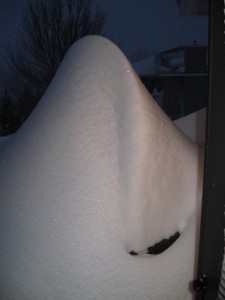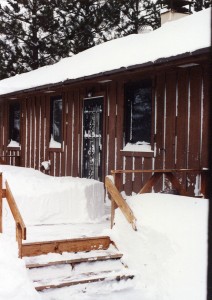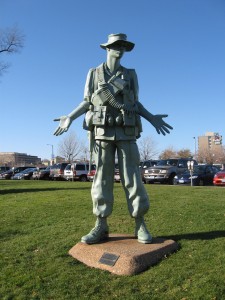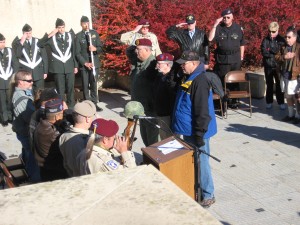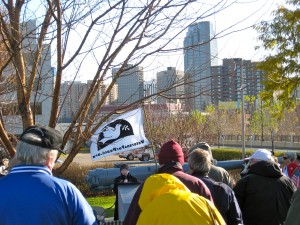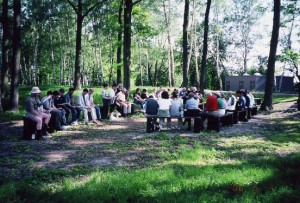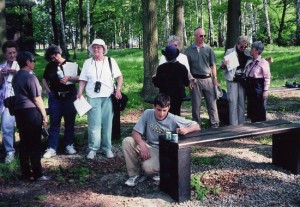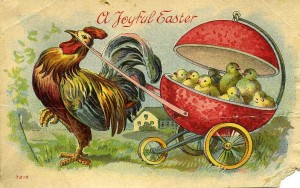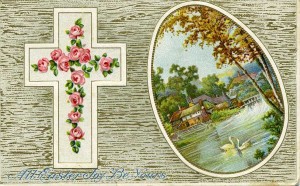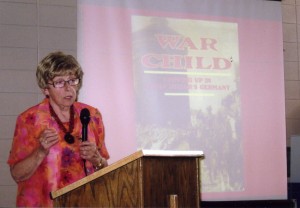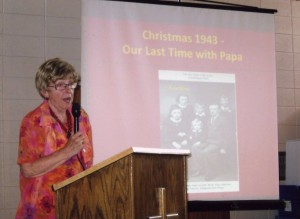#295 – Hunkering down for a Blizzard!
UPDATE 8:15 P.M. DECEMBER 11: Most likely we have over 20″ of snow at our home, thus far no wind. Didn’t leave the house all day. More snow than expected.
UPDATE II 8:10 A.M. DECEMBER 12: We can now classify the storm as a modern day catastrophe. Not only was the Vikings-Giants game postponed till Monday, but at least part of the Metrodome roof apparently has collapsed under the snow.
The storm lasted only 24 hours, and it didn’t even approach blizzard standards, at least where we live, but it was an unusual time for us.
At the end of yesterday’s post are some memories of past times storms.
There’s something energizing about a blizzard, even if you’re totally disabled and immobile (translated: not going out for coffee) as I am at this moment.
We’re in the fairly early stages of what they’re calling a blizzard – plenty of fluffy snow thus far, but relatively little wind. Once the wind comes along, those harmless little pieces of fluff will be even more disabling.
So there’s little to do but revel in the warmth of a home (we’re fortunate) and reminisce…about blizzards I have known.
Recently I completed a history of my French-Canadian roots, and a bit player in that history was Father Joseph Goiffon, called the “peg leg Priest”.

Fr. Goiffon lost his leg in a mis-adventure when caught in an All-Saints Day (Halloween) blizzard in 1860 near where the Park and Red Rivers come together in northeast North Dakota. Fr. Goiffon only lost his leg; his horse froze to death. His nephew, Duane Thein, edited a most interesting 91-page book, still in print, about the near-tragedy in 2005 (see cover, above). Father Goiffon lived on to re-tell the story many times. He died in 1910.
I survived, somewhat more comfortably than Fr. Goiffon, the Halloween blizzard of 1991. I was living in Hibbing MN at the time, and it was said we got over 30 inches of snow which, after the wind, became the hard-pack flakes famous for igloos and fun for kids to build snow caves and forts.
For adults, such blizzards are usually the pits, even if in comfort (last night in a grocery store line I was chatting with the guy behind me who said the liquor store line had been even longer….) Yah, I’ll hear the high-pitched whine of the snowmobiles shortly, but mostly we’re house-bound.
In Hibbing, we were immobile for what I remember to be several days. There was nowhere to go, and no way to get there. Immobility for we in the mobile generation is difficult.
Growing up in North Dakota, I became accustomed to blizzards – two or three of them a winter, it seems.
Unlike today’s blizzard, which was pretty accurately forecast, in those days in the 1940s and on, wise sages had to read the skies and we had to act prudently to avoid being caught in a killer out in the country. You knew those mean storms were out there, but you didn’t know exactly when they’d hit or how bad they’d be.
But if you were indoors and had enough food and fuel, you were okay.
Afterwards, you could walk on the rock hard snow banks, and the kids would work harder than they’d ever work doing chores, digging snow caves and building snow forts and doing all the things kids can do when presented with a new opportunity.
I think of the Elgin ND Blizzard of February, 1965 – a bad one. But it is just another example. They happened every year.
I write in the early stages of this one, so I can’t project what it will be like a few hours from now.
It appears to be of relatively short duration, but if it gets windy, watch out.
So far, nobody’s out for fun. Those who are out are busy.
Today we’ll put up the Christmas tree….
Happy Holidays.
UPDATE: Some responses to the above post:
From Mel Berning, Eureka CA, who recalls a storm he lived through in rural Berlin, North Dakota, right after WWII.
“There were lots of memorable blizzards in N. Dak. but only one remains in my
mind. Dad and Mom came to the Dakotas in 1906 and i remember dad telling about
blizzards so severe you couldn’t see anything but dark lightness in the height of
the storm even during the daylight hours. As a wise kid I discounted these wild
stories as a flight of fancy until one day in deep winter I experienced just
that.
My brother Gus and I decided to get the chores over quickly and do them at 4:30
in the afternoon. It was in the winter of [19]46?? and Gus was home from the
service at the time and staying on the farm with us. To get on with it we went
into the summer porch and lit our kerosene lantern in preparation for the trip
to the barn, a distance of about100 feet. We stepped out of the porch door and
the wind blew the lantern out, I turned to my older brother and hollered lets
hold hands till we get to the barn, surprisingly he gladly complied and we
stumbled blindly on through the howling snow hand in hand. Fortunately I had been
to the barn so often that we collided with the side of the barn and felt our way
around to the door. I kept hoping one of us had matches to relight the lantern
because it was dark as ink. We slid open the barn door, stepped inside, and lo
the lantern was still lit. neither of us could see it in the blinding snow and
it surely was a relief to have light.
Another winter story if you would, We had a 2 week snow with constant blizzard
conditions. As can be expected, dad was out of tobacco and we were running low
on groceries when the storm suddenly stopped and a Chinook [wind] came up from the
south. The temperature rapidly climbed to 50+ and my neighbor and I started to
plow our way to the store in Berlin [about five miles away]. By 3:00 o’clock we were able to reach the
plowed highway and returned home. We both picked up our grocery list and headed
back to Berlin to buy the family groceries. After doing the shopping we decided
to go to the Oasis, the pool hall, have a beer and shoot a game of pool, We
barely got to break the racked balls when some one came in and said it was
snowing out side. We hung up our cues and headed for home. The blizzard was
back and the temperature was dropping rapidly, we got to with in 2-1/2 miles of
home when we hit a new drift on the road and it was home from there on foot.
When I got home dad and mom were very relieved and by that time the thermometer
was on the minus side of 10 below. Several people and some stock died in Dakota
that night.
From Myron DeMers, Fargo ND, who grew up in rural Grafton, ND:
When you mention blizzards and I see so many people outside using snow blowers right now in Fargo, I remembered asking dad years ago if they did a lot of shoveling “in the old days”. His answer surprised me. He said “yes and no” because with all the farmyard traffic, horses, sleighs etc the snow would pack down and most of the winter was spent riding on top of the snow rather then shoveling it. He said the only problem was Spring when it became a muddy mess but by then you were so happy to see Spring, the mud was “clean mud”. Merry Christmas, Myron
From Ellen Brehmer, Grand Forks ND, who grew up in rural Langdon, ND
I hear your supposed to get ‘a bit’ of snow & wind. We are breathing a great sigh of relief because this one will miss us. We’re just sinking into the depths of 20 to 30 below, and that’s not wind chill. We do have the wind so I’m sure the old snow will drift some. It’s always fortunate to be home when the storms hit.
One winter possibly late ’50’s we had to walk a mile across the field in the evening because the car got completely stuck and flooded trying to break through a snow drift on Schnieder’s corner. That’s 1 1/2 miles from home. We walked over the hard pack at an angle so it was probably only a mile – I’m here to tell you that my thighs were very very cold. I’m pretty sure that it was [siblings] Pat, Jerry, Marilyn and myself who walked behind Dad. We had been to some church thing or something. Nothing else got that cold, we all had scarves and mittens and boots, plus we were moving – the front thighs took the beating. So guess what gets cold first for me when I’m shoveling, yup the thighs.
From Mary Busch, Minneapolis, who grew up in ND and northern MN:
Your dad loaned my parents the car to drive to the Carrington Hospital [14 miles away] where I was born during a bad snow storm. (being a geographer-could we find info about that storm?) Late in her life mom revealed I was nearly born in the car. I always wondered about the very flat section of my head—-…
Growing up in Rugby North Dakota, we walked everywhere.
I valued my turquoise fluffy wool coat purchased in Herbergers in Grand Forks ND. The Little Flower School costume was skirts with white cotton socks with metal clasps tied to elastic garters holding them up… rubber boots over shoes and maybe pants… I remember the metal clasps near your skin burning and leaving red marks on cold days. It was a six block walk.
I craved excitement and would walk to the high school to watch Basketball games- Paul Prestis [Presthus?] became a star….It was so cold and about a mile there.
My parents STORED meat in a locked wooden box by the back door….a homemade freezer.
My dad had a complicated ritual involving army blankets to start the Plymouth in cold weather…We often visited relatives for vacations.
A geologist guest in the 1990s was raised in Siberia and commented that Rugby was exactly like Siberia in climate and geology so we had shared similar childhoods.
My dad would take us out ice fishing in very cold weather. We walked back into northern MN lakes, built a fire and drilled our holes. I kept my Rolliflex camera under my jacket so it did not freeze. I often brought guests home to Babbitt and recall an amazed despairing New York City gal, when I explained and demonstrated the toilet opportunities in subzero wilderness.

